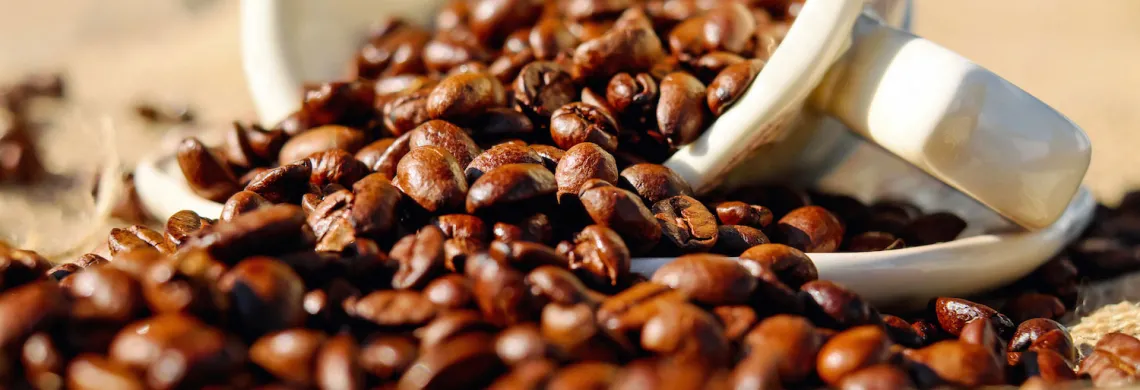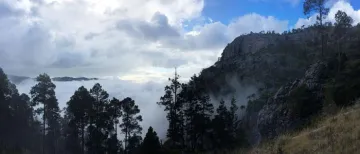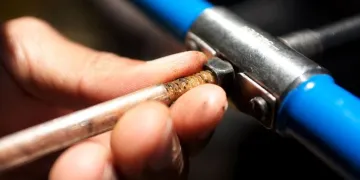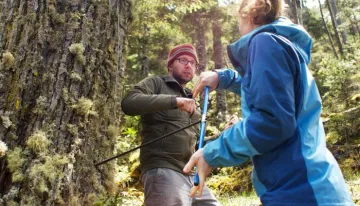For Threatened Coffee Crops, Tree Rings May Offer Answers
On the mountainous slopes of Guatemala, coffee fields are threatened by changing rainfall, rising temperature, and a pathogenic fungus called "coffee rust." Tree rings may help scientists understand and address threats to Guatemalan coffee crops.

Kevin Anchukaitis went to Guatemala for the first time in 2008. Anchukaitis, associate professor in the University of Arizona's School of Geography and Development, was there to scope out trees in the Sierra de los Cuchumatanes, the highest non-volcanic peaks in Central America. Anchukaitis returns to Guatemala often to pry slivers of wood from the trees there, and to meet with collaborators and community members.
This morning, Anchukaitis sits in his office in the Bryant Bannister Tree Ring Building. A handsome blue tea kettle rests on a small table next to the door, but he never fires it up, he says, gesturing to his second cup of coffee for the day.
After raw sugar and bananas, coffee is one of the top exports in Guatemala. In 2014, Guatemala exported about $756 million worth of it. Coffee is also one of the reasons Anchukaitis has been using tree rings to peer into the country's past rainy seasons and temperature trends. Coffee is a pretty finicky crop, or as the scientist puts it: "Quality coffee comes from a narrow range of climate." Coffee bushes thrive with about 60 to 90 inches of rainfall annually; in Guatemala, the rain comes between February and May. It doesn't like to be too hot or too cold, too high or too low in elevation. Thus far, Guatemala's climate has been able to graciously host the crop, and its economy has depended on it.
But existing climate models, which predict decreased rainfall and rising temperatures, suggest that Guatemalan coffee bushes face an uncertain – even unfavorable – future. These models, however, are based on quite limited climate records from Guatemala, so Anchukaitis's work (filling gaps in the data and meeting with farmers and stakeholders) asks two questions: Are the models correct? If they are, how can the country adapt?

Guatemalan Fir and Colorado Pine
In answering these questions, the lack of good climate records on Guatemala is a problem. "We need to expand our knowledge and reconstruct the past to really put present changes in climate into context," he says.
Tree rings are Anchukaitis's tool of choice for reconstructing the climate of the past, or paleoclimatology, as it's called. As a matter of fact, tree ring science was invented at the UA by a polymath named Andrew Ellicott Douglass who established the Laboratory of Tree-Ring Research, where Anchukaitis now works, in 1937.
There are two species of trees native to the coffee-growing regions of Guatemala that Anchukaitis uses: Guatemalan Fir, which is now threatened due to human exploitation, and Colorado Pine. Both trees put on annual rings that are related to precipitation. The wider the ring, the more rain fell that year.
So far, the firs' rings are best for reconstructing past rainfall. The pine is more difficult, because some years, it doesn't put on a ring, but the pine has an allure of its own. The anatomy of its wood is different. According to Anchukaitis, he may be able to use it to reconstruct past temperatures. Some trees in other parts of the world can be used this way, where the density of the tree ring reflects the temperature of that year. But this hasn't been applied to tropical trees before.
Although tree rings can tell scientists about the past, Anchukaitis has only been able to reconstruct climate patterns as far back as the 1600s.
"One of the interesting challenges in Guatemala is finding older trees. The trees there are pretty young compared to what we're able to find in arid sites," Anchukaitis said. By comparison, there are bristlecone pine trees in the Great Basin about ten times as old as those he's sampled in Guatemala. Tropical trees just don't tend to get that old, he says, adding, inadvertently poetically, "It's not always true, but seems to be that oftentimes adversity leads to longevity."
What's more, people have been living in Guatemala for thousands of years, and, throughout that time, have needed to chop the trees for wood to burn and to build.
Even still, having a Guatemalan climate record dating back to the 17th century is a feat, and one that has offered insights into the future.

From Old Rings, New Knowledge Emerges
"All climate right now is an amalgamation between natural, or unforced, climate variability, and human-influenced climate trends. Anywhere you go now, that's true, because we (humans) have had such a widespread influence on the climate system," says Anchukaitis.
In other words, climate is both the result of Earth's natural rhythms, and human behavior. This has been true for as long as humans have been making scientific observations about climate, which, of course, presents a challenge: How do we untangle what's caused by natural rhythms, and what's caused by us?
"We don't really have a picture of climate unmodified by humans," says Anchukaitis.
To uncover this picture, scientists have to know what the natural rhythms were for centuries before humans began to influence climate. Tree rings allow that.
"Tree rings give us a long-term perspective, and rich context, on patterns of wet and dry from year-to-year and decade-to-decade," says Anchukaitis. This way, scientists can tell what's outside of the range of natural variability and what's not. And they can use information from tree rings can help us evaluate climate models, like those that say less and less rain is on the horizon.
The firs and pines that Anchukaitis has studied reveal that the last 20 to 30 years in Guatemala are not actually all that exceptional in terms of rainfall: "So far, there's no sign of onset of an imminent drying period in Central America. What we see so far could be explained by the natural variability that's characteristic of the last several centuries," Anchukaitis says.
"Does that mean the models are wrong? No. But it provides context," he adds.
The tree rings have also revealed that, in Guatemala, there can be up to eight consecutive years where the transition from dry to wet season is late, or dry.
"If that were to happen now, it would have big implications in terms of the harvesting of coffee crops, as you can imagine, but the paleo-record does reveal the potential for that," says Anchukaitis.
Members of Anchukaitis's research team, including Diego Pons, a Guatemalan graduate student of geography at the University of Denver, are collaborating with Guatemala's coffee stakeholders to better understand and prepare for that potential.

The Coffee Ecosystem
Aside from dry seasons, there are a number of environmental threats to Guatemala's coffee crops.
"With the tree rings, we're able to look at precipitation most directly. Temperature is a related, important issue. But even more pressing than that is coffee rust," Anchukaitis said.
Coffee rust is a fungus that infects the leaves of coffee bushes, intermittently devastating Central American crops. It covers the upper surfaces of the coffee leaves in buttery yellow blemishes, and their undersides with chalky orange lesions. According to Anchukaitis, it almost certainly likes a certain range of humidity and temperature, "so we're trying to figure how that is changing, as well."
Whether or not a crop is prone to coffee rust is "almost definitely tied to climate conditions, so we're just trying to figure out whether climate change is going to make it even more of a threat," Anchukaitis said.
"Knowing what's going on with the climate, in a sort of long-term context, is going to be the key to adapting to any of these changes."
For now, Anchukaitis continues to explore the forests of Guatemala in search of the trees – and the rings – that offer insights into the future of coffee and climate.

